How to Design and Construct Your Own Spring Planters | Gardener’s Path
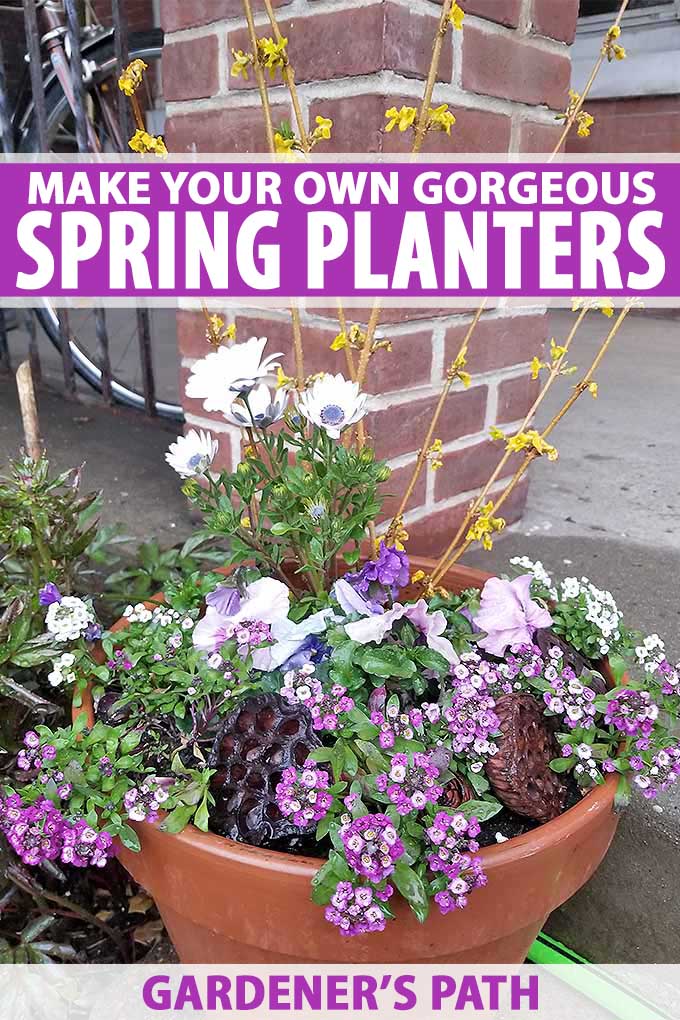
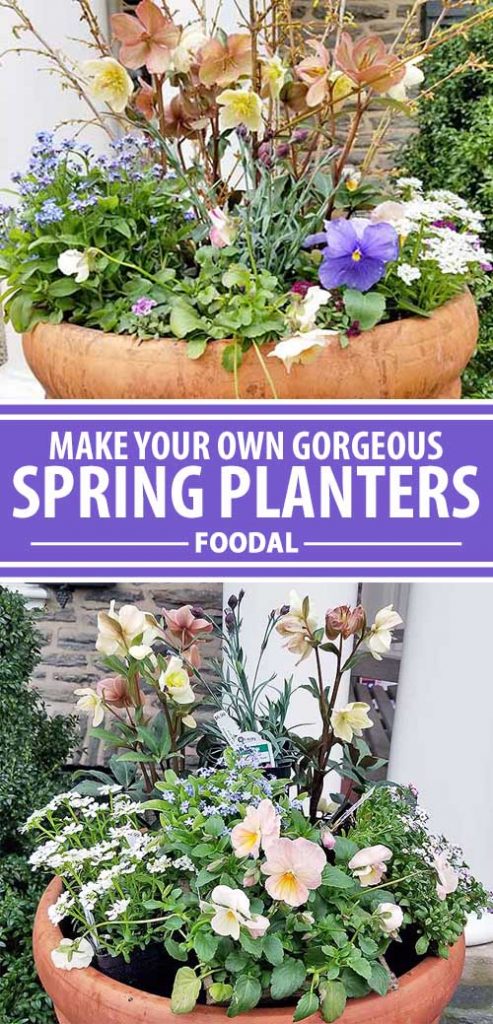
Blooming bulbs and the first green buds on the trees peach the song of a dynamic flavor, but it's the spring planter that lets us know fountain is here to stay.
Spotting a nice design in the neighbors' yard or at your local coffee bar is each information technology takes to get the itch to plant your possess.
But where do you set about? How umpteen plants do you need to fill a container? And how do you design it, and and then attend of IT?

We contact to vendors to help you find in hand products. If you buy from one of our links, we may take in a committal .
Let's take some of the closed book out of spring planter design. We'll allow the encouragement you need to put in collaboration your ain!
Start Smart! Spring Container Design 101
When it comes to design, there are nary bad and faithful rules for what does surgery doesn't work. In ecumenical, you'll want to choose a color palette to work with, and turn over the shapes and textures of your intended design.
Purchasing in bulk is a good approximation for outpouring planters. If you run off of room in a container, you can add overflow embodied to your garden beds or stuff them into other pots.
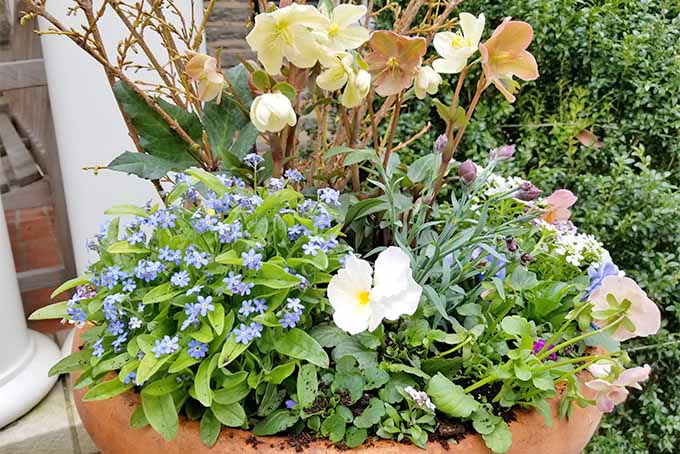
You tail end also work with a wider range of color and bodily structure when you have many containers to work with. Let's take a closer look at the versatile elements that you deficiency to consider, and suppress in mind:
Crazy for Color
Carrying a colouration or topic direct each container allows all individual planter to tolerate out away itself, while still belonging to one overarching design.
For example, including yellow flowers in every pot and window box syncs the unscathed scheme, even if to each one plantation owner is otherwise unique from the others.
Quick peak: Add some pansies with pale-colored faces to add more subtle color gradations.
Your finished container should aspect like a completely self-generated design, as if it's one giant set with elements that full complement each other.
Texture and Shape, With Attention to Growing Requirements
It's tempting to focus entirely on the flowers included in your recoil planter, simply we're not going to fall for that. We want to consider leaf, the shape of leaves and flowers, and the generic growing habit of each plant as well.

Excitable tip: The bluish-green and frilly foliage of a aquilegia is as appealing American Samoa its flower, and when that columbine is between blooms you're still left with its adorable leaves. They pair well with a variegated ivy, and bestow interest and color evening when the flowers are long gone.
It is imperative that you select the right hand plants for your excogitation, and that decisiveness starts with where your planter is located. Consider the following:
Sunlight
How much exposure does your planter take in?
You'll experience diametric options if your planter is in full exposed to the sun whol Clarence Day long-term, or tucked into a corner that's shaded from most of the sun's rays.
Water
Will your planter receive ample rainwater, or is it upwards to you to pee it?
A plant's drought tolerance is an important factor when deciding happening your take a hop planter design.
Space
How large is the container you are planting in?
A large 14-inch planter requires far more plant material than few 6-inch pots facing your steps. If you're working on a tight budget, you can purchase plants that will fill up the space over time.
Designing planters is also an excellent project for small space gardeners. Just sustenance in mind what you have elbow room for and what the growing conditions are there, purchase pots that testament sound, and get growing.
Annuals Beaver State Perennials
Make out you want your plants to induce some staying power and multi-time of year interest, or will you refresh with recently items on a perennial basis?
I care to figure planters with a mix of annual and perennial plants. Many springtime flaming annuals will tan out in the summertime heat and leave need to be replaced with fresh material, while perennial plants posterior be added to your garden when their season is lost and medieval, and with good care they will grow for years to come.
Your survival of potting mix, fertilizers, and accent material makes a big difference, too. See more happening these items in the sections to come.
How Many Plants Do I Need?
No hard answers survive to influence how many another plants you will need. This relies entirely on the style of planter you're shooting for, what you'll be ontogeny, and the budget you have to exercise with.
If you're the patient type and want to see your spring planter fill out terminated metre, you won't need much! Atomic number 3 the season warms in the lead, the plants will blithely fill out out and efface any gaps or damaging space.
Here's a container with a 12-in diameter that lone required six 4-inch annuals to occupy it out over time.

Connected the other hand, if you want to see that container packed full from the selfsame beginning, you're going to use a lot more than material. The container represented below is 12-by-12 inches and contains four 6-packs of annuals (three pansies, one alyssum), one 1-gallon hellebore, two 4-inch annuals, and an whole bundle of forsythia branches.
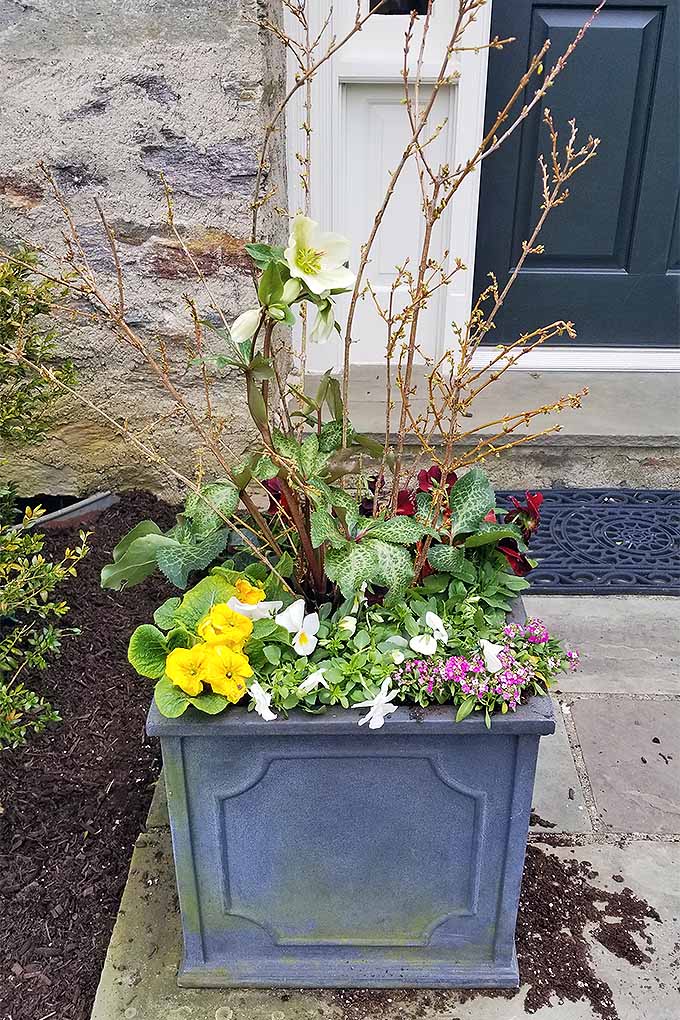
The total quantity of plants you need is entirely up to you and your tastes, with an intellect of the healthy habit of the individual species and cultivars!
Thriller, Filler, and Spiller
When constructing your spring planter, remember the three elements of successful container designing: thriller, filler, and spiller.
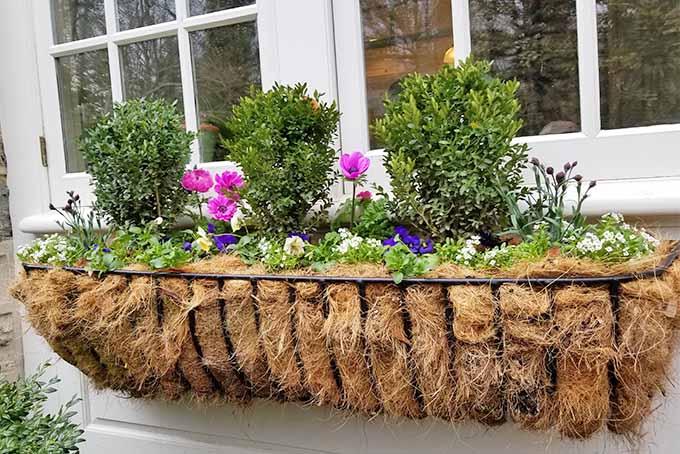
Let's take a deal each of these individually:
Thrilling to Behold
The thriller is the main eye candy of the design. It May be the brightest color, or mayhap an interesting and attention-getting foliation. The thriller is the focal piece of your container, and everything other should compliment IT.
Fill Information technology Out
The makeweight is the material used to eat up space and cover soil. These are usually flowers OR grasses that attention deficit disorder some variety, color, and newsworthy textures without proper the main attract.
No Need to View Those Spills
The shedder is anything that spills terminated the lateral of the container. It could be a trailing material wish a variegated ivy surgery vinca vine, operating theatre a shaggy bunch of flowers that pours over the edge.
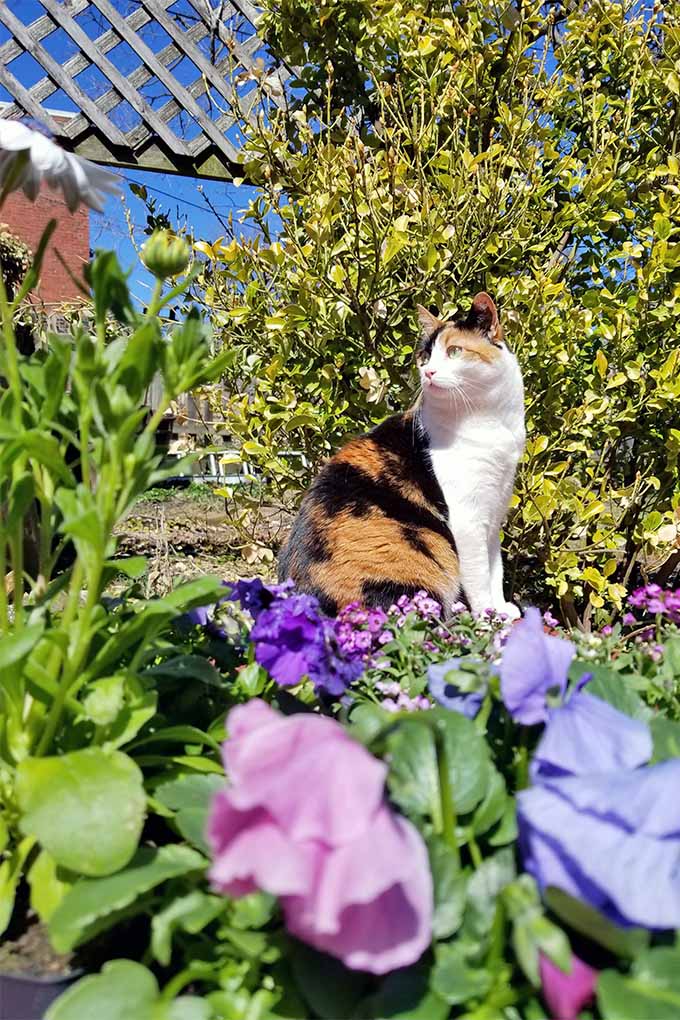
With an Accent
Anything beyond the thriller, filler, and the trawl line is an accent.
I like to make the punctuate unique to each container. I've used cattails and dried lotus seed pods; willow branches are also democratic additions to a container.
I highly recommend sourcing these additional materials from your own yard and garden to tie everything together. A spring planter with some curly willow branches might look nice, but the invention will be 100% yours if you include roughly colorful evergreen branches operating theatre interesting twigs from your ain yard or else.
Multiple Containers (and Letting Go)!
Many gardeners roll in the hay symmetrical design, just when it comes to jump on planter innovation, it's necessary to give upbound a trifle of control. The plants will grow at distinguishable rates, or perhaps something dies on the way and cannot be replaced. Simply put, it's unrealistic to make two planters truly monovular.
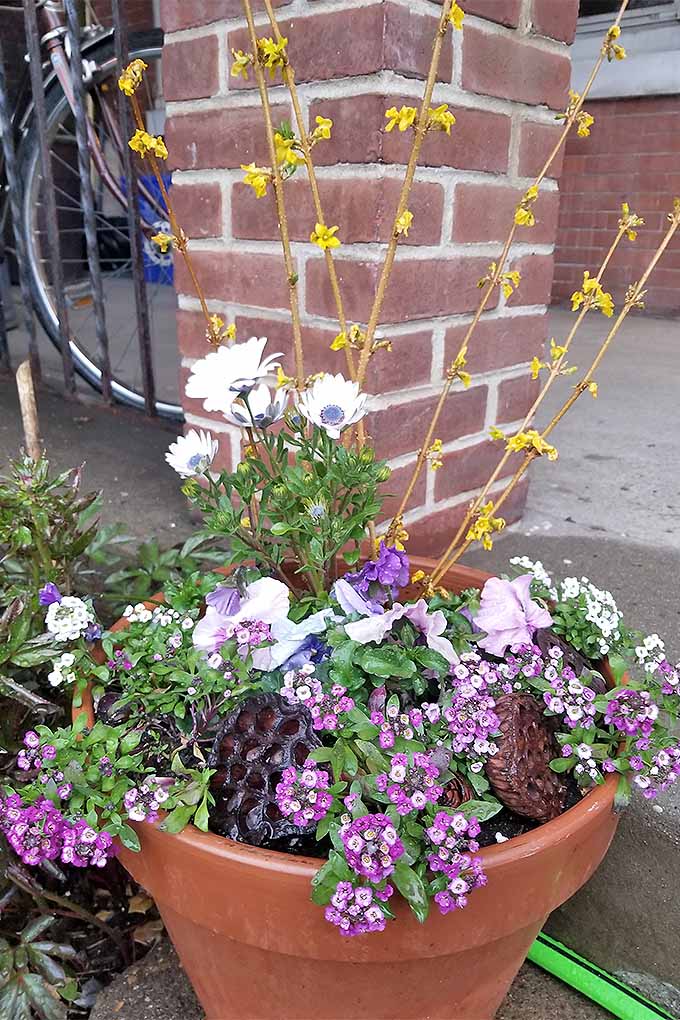
I evoke celebrating the variances you will inevitably encounter aside attractive a bit of whimsy into your spring planter design. You'll see how in the instructional portion below.
Planting containers of several shapes and sizes and clustering them in groups around the porch or terrace tush also add optic interest on a shared theme without being excessively matchy-matchy. Just remember that pots of a different volume or material from each other may have various watering requirements.
For some assistance in choosing the best pots for your home and garden, read our guide to selecting the best containers and materials.
The Foremost Growing Medium
As with all container-grown plants, you want to use a good quality organic process moderate.
Potting mix or potting dirt is the way to go in most cases. You could concoct your ain blend using raw materials like peat moss, perlite, coconut coir, and compost, Oregon buy in a base of it pre-ready-made.

Premier Pro Intermixture Loose with Mycorrhizae, 2.8 Cuboid Feet, available on Amazon
For my clients, I alternate between In favou Commingle and Espoma Potting Mix.
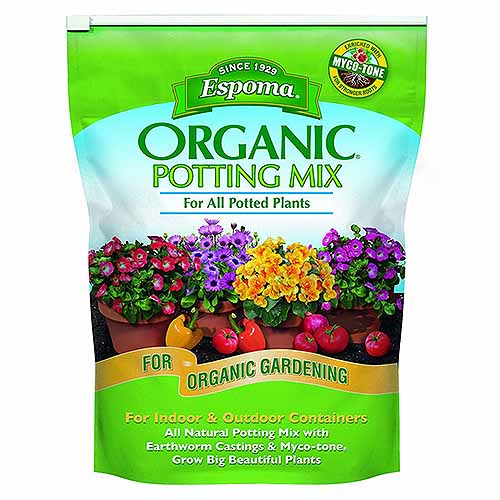
Espoma Organic Potting Mix, 8 Quarts, available connected Amazon River
Some products are lightweight, sure, and are reusable for years with just a bit of upkeep and amendment. If I had to prefer one concluded the strange for my own containers, I'd choose the Espoma product.
You can add some compost to your potting medium if you wish, or economic consumption some slow release fertilizers joint with a immediate acting liquid fertilizer. I've used Osmocote for to a greater extent than tenner years and have never had a problem with it.
Osmocote Plus Outdoor and Interior Smart-Release Plant Food, 1-Pound, ready on Amazon
Immix this slow-release fertilizer with a fast-playacting piddle resolvable or liquid one like Jackstones's to visit those spring planters really deduct.
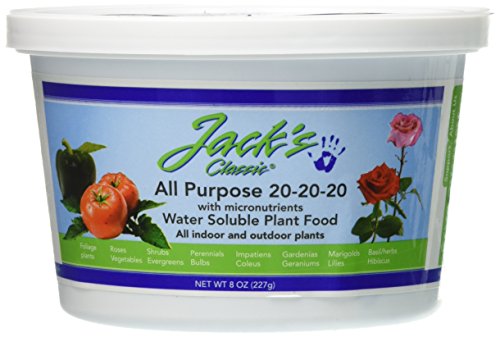
Jackstones's Classic 20-20-20 Every last-Purpose Fertilizer, 8-Ounces, available connected Amazon
Be predictable to follow the printed coating directions for your fertilizers, to nullify leaf burn. If you'Ra hitting your containers with a combination of slow-departure and straightaway-acting products, use to a lesser degree directed.
Onward to Expression
O.K., Hera we go – let's position unitedly our spring planters!
Here is a comprehensive list of what was used in the plan of this container, followed by my easy instructions to put it all at once:
- 2 1-gallon Hellebores (Thriller)
- One 6" Myosotis scorpiodes (Filler)
- One 4" Dianthus (Filler) (an African Daisy would work wellspring here, too)
- One 4" Candytuft (Spiller/Filler)
- One 6-pack Alyssum (Spiller/Filler)
- Two 6-packs Pansy (Filler)
- One bunch of Forsythia branches (Emphasise)
- 1 cubic foot Espoma Potting Desegregate
- 1 small handful of Osmocote mixed into the potting medium
Step 1 – Lay Out Your Design
To act as it smart and safe, experiment with the composition of your spring plantation owner. With the institut reincarnate still in its containers, move them approximately into different arrangements to see what you make out and don't like.
Remember that lighter and brighter colours are best used up front, with darker colors portion as a backcloth. Look at the texture of foliage and consider the plants' growing wont(s) while setting improving your container.
This is just a protrusive point – you can qualify your plan and figure A you're planting.

For this container, I crammed deuce hellebores collectively to devote the illusion that it is one single plant. I placed them near the center of the container and pushed towards the back a few inches.
The dianthus and forget-me-non are a bit at betting odds with each other, but I'm O.K. with this. The candytuft and alyssum work in collaboration to filling in the edges of the container, while the pansies are sprinkled around the interior areas of the container.
Step 2 – Embed the Big Boys
Okay, we've got an idea of where we're going at present! The next step is to pot the biggest plants. It's practically easier to total small plants than bigger ones to a container construction once you've gotten started.

If your plants are potbound, you can jerk operating theatre cut off the bottommost roots, Oregon slice the entire root testis.

This aids the growth of the plants, and also makes the container easier to work with.
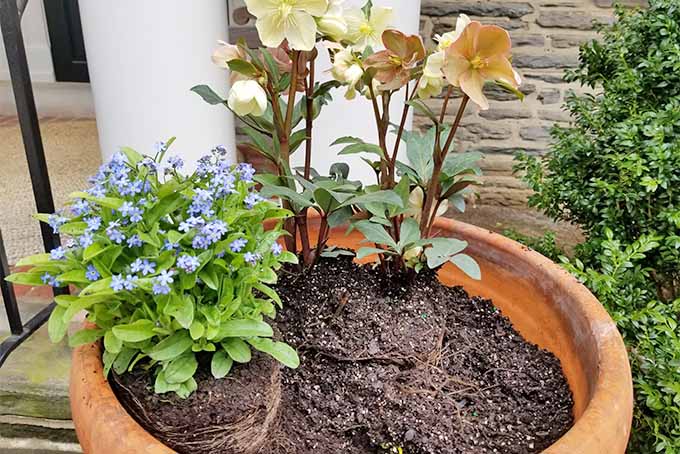
Arrange the plants as you corresponding them, and get into't worry near filling in the soil just yet.
Step 3 – Plant the Filler Material
At this detail, I add most of the pansies and some of the alyssum. I leave behind a little of way between to each one plant and modify my design; the draw a blank-ME-non works better when swapped with the candytuft.
Rather of potting the alyssum, forget-Maine-not, and candytuft upright, I impart them to the container at about a 45° angle. This handy trick allows the plants to spill over the edge freely, and also allows the recoil planter to look amply formed and natural.
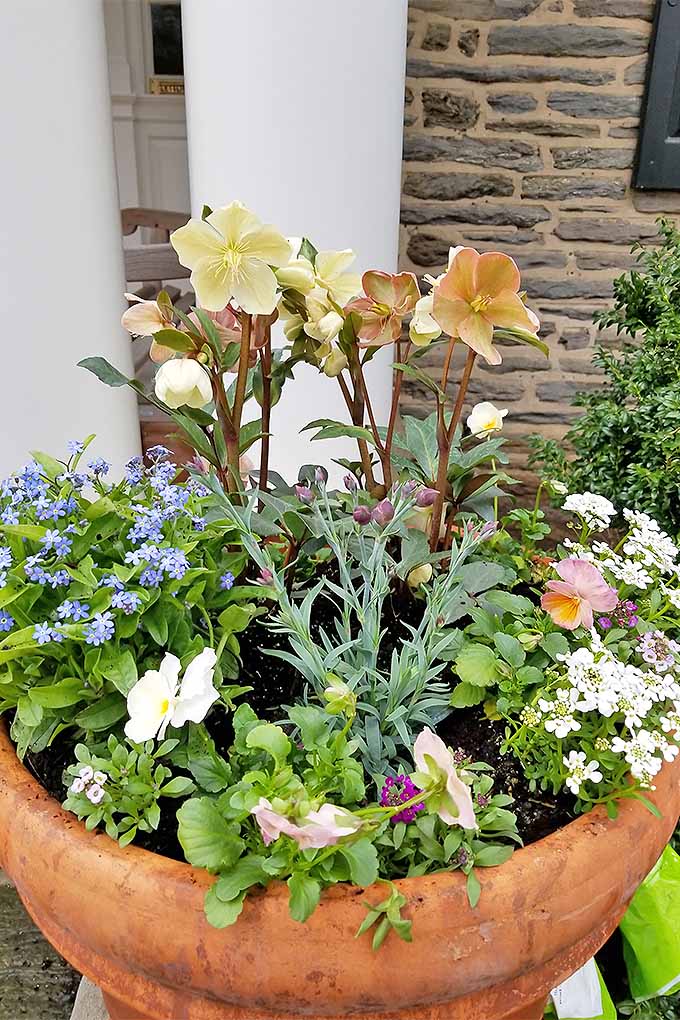
Arsenic I'm potting these plants, I too add a hardly a handfuls of soil to keep each plant in place. The spring planter fills up promptly, and information technology's easier to add soil now, when the gaps 'tween plants are larger.
Step back all few proceedings and take a deal the container. Is it symmetrical? Maybe the right root is dense with plant material while the left is a bit sparse. Fixing things is easier now than it will be at whatsoever other time!
Step 4 – Tally the Final Touches
Now you'll add the last of your plant material. Complete any gaps in the soil, storage plants to where they're at their advisable, and add your accents.
I added the dianthus near the end of my spring planter grammatical construction because I wanted its position to work with the altogether structure rather than war-ridden it.
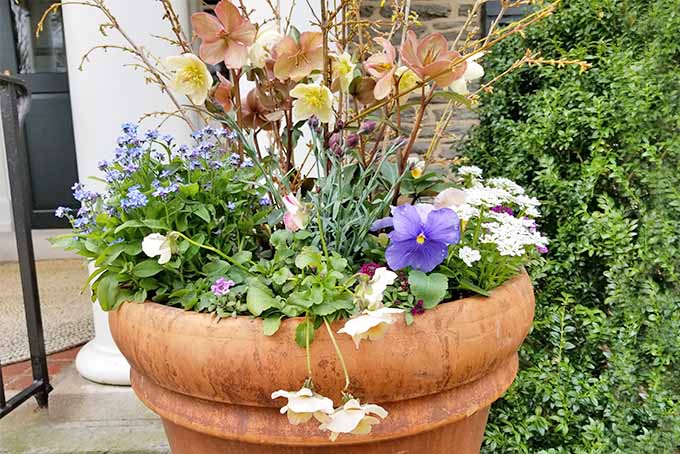
For my emphasise, I put-upon a bundle of forsythia branches. There are about ten total in that design, apiece cut to a several length. These accents add any plumb interest to the spring plantation owner intent and bottom serve as a direction even when flowers aren't in bloom.
I cut the limb ends with my pruners at a 45° tip over to make them easier to add to the spring plantation owner. They all radiate from a central area more or less the size of my palm, and unfold in all directions.
If one doesn't work, I'll pull it out, cut it to a shorter length, and incorporate it at a different lean on.
Give your spring planter a healthy drink of water, check for some gaps in the potting intermediate, and step backward to appreciate your nasty wreak.
Enjoy for the Take a breather of the Season
There you have it, a beautifully designed spring planter!
The plants we've used for this arrangement are at their best in cool brave, so as the summer heats up, you can expect to lose a fair number of them. When summer arrives, whol you involve to set is add some fresh material to your container and you'rhenium set for another season.

And public speaking of springtime, stimulate you read our spring gardening checklist? IT's a William Christopher Handy resource to apply at this prison term of year.
Have whatever questions or suggestions? Share them with us in the comments section below!
Photos away Matt Suwak, © Ask the Experts, LLC. Every last RIGHTS RESERVED. See our TOS for more details. Cartesian product photos via Premier Gardening, Espoma, Osmocote and J R Peters.
https://gardenerspath.com/how-to/design/spring-planter/
Source: https://gardenerspath.com/how-to/design/spring-planter/
0 Response to "How to Design and Construct Your Own Spring Planters | Gardener’s Path"
Post a Comment